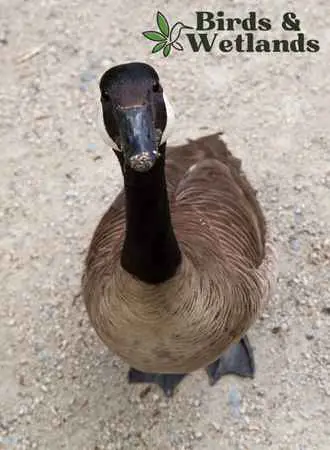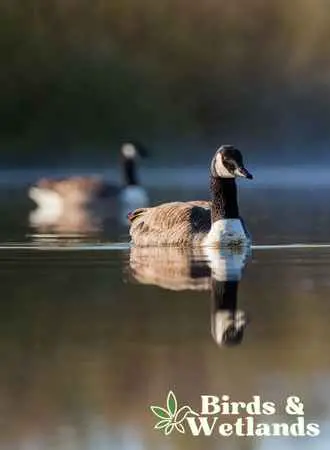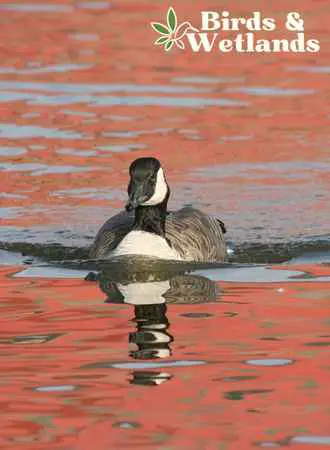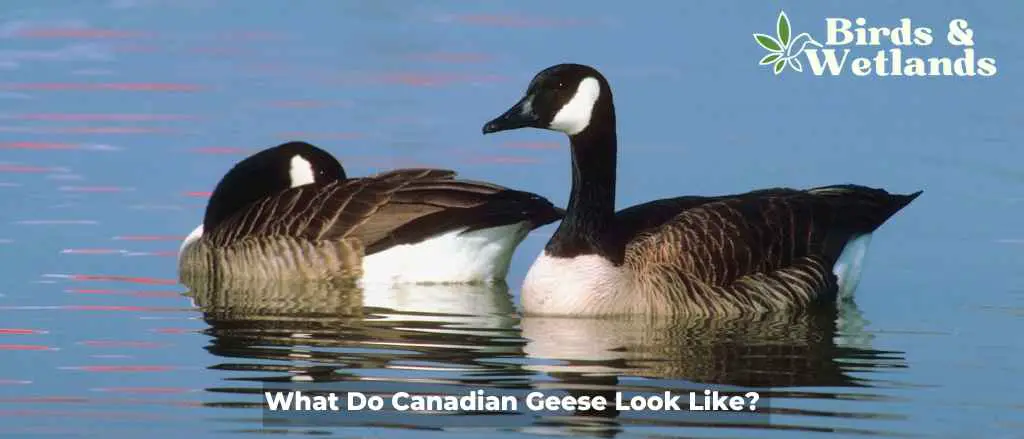Canada geese (Branta canadensis) are large waterfowl with a black head and neck, white cheek patches, and brown bodies. Canada geese range from 8 to 12 pounds in weight and 3 to 5 in length. The plumage details of both sexes is similar, though females are slightly smaller than males. Their wingspan can reach up to 6 feet, making them one of North America’s largest flying birds.
Most Canada geese live near bodies of water, feeding on aquatic plants and small animals. They typically mate for life and often return to the same nesting location year after year.
Due to climate change and the availability of food sources, these majestic birds have become a common sight in many parts of North America.
Key Points on the Appearance of Canada Goose

What are the differences between Canadian geese and cackling geese?
Cackling geese (Branta hutchinsii) were a Canada goose species but are now seen as their own species. The two species have somewhat the same appearance, with many people incorrectly identifying the Richardson’s cackling goose as the lesser Canada goose There is an overlap in size between the smaller subspecies of the Canada goose and the larger subspecies of the cackling goose.
Cackling geese are smaller birds with stubbier bills and rounder heads. Some subspecies of cackling geese have a white collar. They also have a higher-pitched call than the larger Canada geese. The neck length is also different. The cackling goose is a small goose with a shorter neck than the Canada goose.
The other difference is behavior. Cackling geese tend to live and breed in colder areas, such as the Aleutian islands further north, than Canada Geese. And while the two species of geese congregate in places like local parks and other densely populated areas, Cackling geese more often live in open areas of land with few trees, while Canada Geese prefer areas near water that have more trees.
Canada and cackling geese are similar in size and appearance, making identification difficult. In some cases, the two species even live in the same flocks.
Cackling and Canada Geese hybridization can make distinguishing one from the other even more difficult. The characteristics of hybrids are usually intermediate between the two parent species. In most cases, the hybrids are fertile and can produce their own offspring. However, there are some cases where hybrids are sterile.
The hybridization of Canada and cackling geese are likely to continue as the two species interact more frequently.
Do all species of Canada geese look the same?
Though all seven subspecies of Canada geese look the same, they differ in size. The giant Canada goose is the largest of the bunch, while the lesser Canada goose is the smallest. At one point, the Aleutian cackling goose was the smallest of the bunch, but it has since been classified as its own separate species. But no matter what species you’re looking at, these magnificent birds are sure to impress.

Do male and female Canadian geese look different?
Although male and female Canada geese appear similar, one significant difference is size. The female Canada goose is slightly smaller than the male Canada goose. The difference in size between the sexes may vary depending on the subspecies.
It has also been observed that the male Canada goose has a slightly brighter plumage than the female Canada goose.
While size and plumage distinguish male and female Canada geese, there are other subtle differences between the two sexes. Males, for example, have a deeper honk than females, and their wing beats are usually louder.

What other geese look like the Canada goose?
The only other goose species that resembles the Canada goose is the cackling goose. Until 2004, the cackling goose was considered a subspecies of the Canada goose, but it is now considered its own wild goose species.

What is the importance of identifying a Canada goose from a cackling goose?
It is easy to incorrectly identify a cackling goose from a Canada goose, especially smaller Canada geese such as females and immature birds. During waterfowl hunting season, correctly identifying a Canada goose from a cackling goose is important because of the different bag and possession limits for the two species. Incorrectly identifying one from the other can land you hefty fines and other penalties.
FAQs About Canada Geese and Other Goose Species
Why do Canada goose flocks live in local parks?
Canada geese are highly social creatures that congregate in large flocks and are known for their hissing sound when they are about to attack. In the wild, these flocks usually congregate near bodies of water, such as rivers, lakes, and wetlands.
In recent years, many Canada geese have become permanent residents in city parks due to better breeding habitat and food sources. These geese don’t migrate for their breeding season and stay all year long. Local parks usually have an abundance of food, such as grass, insects, and small mammals. Not to mention, it has become a habit for some people to feed Canada geese with all kinds of food, including bread. Some geese have been observed to use their long necks to scavenge food from garbage bins.

Do Canada geese breed up north?
During spring migration, many Canada geese are common species of geese that fly north from their wintering grounds. These geese breed in western Alaska and many parts of Canada, including British Columbia. Some flocks of Canada geese and other species such as the snow geese live close to each other. The vast majority of Canada geese live in family groups and breeding takes place in the northern parts of the country. The climate in the northern regions of North America is more conducive to nesting and raising young there. The long days and warm temperatures provide plenty of food for the growing goslings, and there are few predators to worry about.
During the breeding season, the female chooses the nest site and builds the nest, lining it with down feathers plucked from its breast. The female incubates the eggs until they hatch into goslings. In the incubation period, the male stands nearby. Some adults lose their flight feathers during this time.

Where do cackling geese spend winters?
Cackling geese are long-distance migrants that form groups and spend winters in the southern Great plains, the Pacific Northwest, and California. There might be some changes to their usual migration routes due to climate change but these migratory birds return to their spring breeding grounds in Alaska and northern Canada. Cackling geese graze on grasses, agricultural crops and other plants and nest near ponds and marshes.

